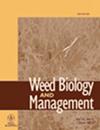入侵杂草 Chrysanthemoides monilifera(菊科)两个亚种的土壤种子寿命差异
IF 1.5
4区 农林科学
Q3 AGRONOMY
引用次数: 0
摘要
土壤种子库的持久性会影响杂草管理方案。然而,对于许多物种来说,土壤种子库的持久性尚不清楚。我们评估了 Chrysanthemoides monilifera subsp. monilifera(骨草)和 C. monilifera subsp.这两个亚种的种子被埋在澳大利亚东部两个地点的两个深度。在长达 8 年的时间里,定期对种子的发芽率和存活率进行检测。新鲜采集的种子存活率很低,在埋藏后的最初几年中,存活率迅速下降,其中 C. m. rotundata 的下降速度比 C. m. monilifera 快。不过,有些种子在某些地点的土壤中仍能存活长达 8 年之久,但地点与地点之间的差异很大。不同地点种子存活率的差异可能与土壤保持湿润的时间长短有关:这与降雨量和湿度水平有关。8 年后仍然存活的种子数量较少,这表明杂草控制后各地点的新种概率逐渐降低,但也表明需要对这两个亚种进行长期监测,以最大限度地降低种子库再感染的风险。本文章由计算机程序翻译,如有差异,请以英文原文为准。
Differences in soil seed longevity for two subspecies of the invasive weed, Chrysanthemoides monilifera (Asteraceae)
The persistence of a soil seed bank influences weed management options. However, for many species, the degree of persistence of a soil seed bank is unknown. We assessed how long seeds remain in the soil for two invasive weeds, Chrysanthemoides monilifera subsp. monilifera (boneseed) and C. monilifera subsp. rotundata (bitou bush), as seeds of these species were predicted to have different longevity in the soil associated with differences in seed coat thickness. Seeds of both subspecies were buried at two depths at two sites in eastern Australia. Seeds were tested for germinability and viability regularly over an 8‐year period. Freshly collected seeds had quite low viability, and there was a rapid decline in viability in the first couple of years after burial, with C. m. rotundata declining faster than C. m. monilifera . Some seeds, however, remained viable in the soil at some sites for up to 8 years, with high site‐to‐site variability. The variability in viability from site to site may be due to the length of time soils remain moist: a combination of rainfall quantity and humidity levels. The low numbers of seeds remaining viable at 8 years indicate progressively lower probabilities of recruitment at sites following weed control but also suggest that monitoring for both subspecies needs to occur for a long period to minimize the risk of reinfestation from the seed bank.
求助全文
通过发布文献求助,成功后即可免费获取论文全文。
去求助
来源期刊

Weed Biology and Management
农林科学-农艺学
CiteScore
2.70
自引率
0.00%
发文量
13
审稿时长
>36 weeks
期刊介绍:
Weed Biology and Management is an international journal, published four times per year. The journal accepts contributions in the form of original research and review articles in all aspects of weed science. Contributions from weed scientists in the Asia–Pacific region are particularly welcomed.
The content of the contributions may relate to weed taxonomy, ecology and physiology, weed management and control methodologies, herbicide behaviors in plants, soils and environment, utilization of weeds and other aspects of weed science. All contributions must be of sufficient quality to extend our knowledge in weed science.
 求助内容:
求助内容: 应助结果提醒方式:
应助结果提醒方式:


